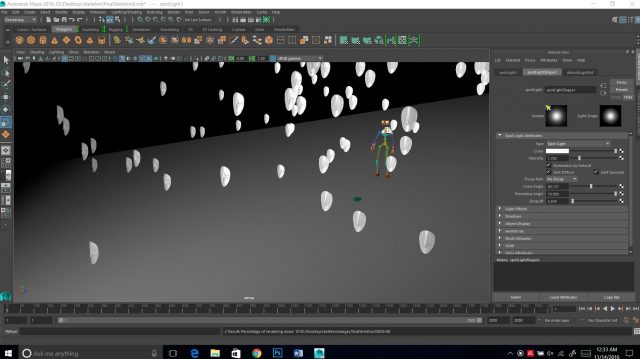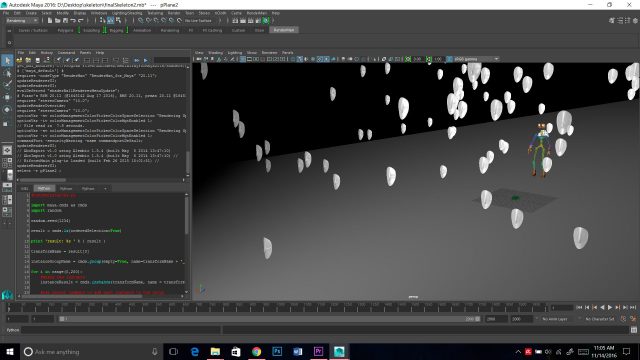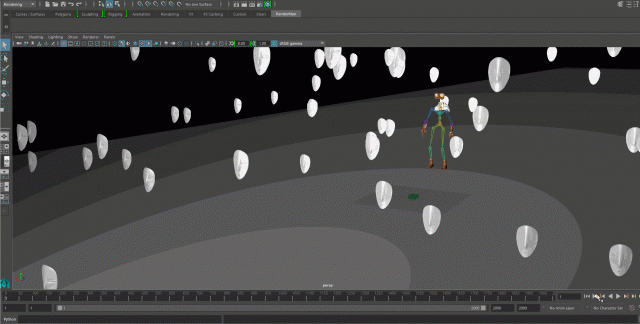Catlu – Mocap
Final rendered video on Vimeo:
Screenshot of the work right before rendering:
Screenshot of the scripting device in Maya:
Gif of time slider animation pre-render in Maya (you may need to click it to see it run):
Sketches I did of the characters:
For my project, Golan suggested that instead of using Processing or Three.js, I could learn scripting in Maya because of my interest in animation. I was very excited to start this project, and took to it with a more story-focused mindset with the motion capture than I think most of the class did. I wanted to use the scripting to do things in Maya that I couldn’t do by hand (or at least couldn’t bear to do by hand or in the given time frame) that would supplement a story, no matter how short. The initial idea I had for this was a pair of disgraced/fallen/unfit samurai that circled each other in blame, getting closer and farther together with an audience of masks turning to look always at the two of them and closing in gradually. Eventually, I realized I didn’t have time to model two samurai and settled on modelling the shell (mask, gloves, socks, cape) of a disgraced/fallen/unfit samurai warrior and trying to achieve a feeling of melancholy and nostalgia for a better time. I wanted to use python scripting to generate and randomly place another modelled mask, and make it so that whenever the main mocap samurai moved, the masks would turn their faces to always follow him. Starting this project, I watched video tutorials on how to python script in Maya, following along with them. After figuring out if I could do what I wanted to do, which actually the video tutorials basically covered, I started modelling. Before this project, I had only had a bit of basic modelling experience and a general broad overview of what Maya could do. The modelling ended up taking me more time than I thought. Afterwards, I also learned how to import a BVH file into Maya and how to rig/bind a model to the BVH skeleton. When I got to coding, I came to an unexpected circumstance. Although the masks would turn to face the samurai, after the samurai was binded to the skeleton, this no longer worked. At first I tried to bind the skeleton different ways, but in the end I made a separate object that I gave 100% transparency that I hand animated to follow the samurai around. The masks then followed that object. In the end, I didn’t end up liking the effect of the turning masks because they made the scene more confusing because the masks didn’t turn enough to be horribly noticeable. After finally getting everything set up and moving, I learned how to render. This is the first time I’ve rendered a scene, and I didn’t expect the end number of frames to be around 2000. The 2000 frames took longer to render than I thought they would. I tried to change the frame rate to 24 fps, but doing so significantly slowed down the mocap. The final step was to take my rendered scenes and stitch them together in Premiere. The end product was slower than it looked in Maya so I sped it up, utlimately shortening it by half, and also rendered darker than my test frame renders. I didn’t have time to re-render all the frames, but I think it was good experience going into the next time I try to render something. In the end I think I’m satisfied with the project, but I would definitely like to do more with it given more time to really get things to move, thinking more interactively along with my story-focus and getting more interactivity (leaving enough time for when things I want to work out don’t and so on). I want to utilize code more and dig deeper into what I can do with it, and also learn more the Maya-Python vocabulary.
Once again the WP-Syntax tool still hates me, and so here is the Github link to the code:




